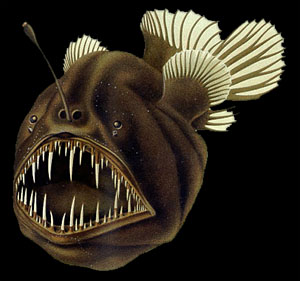
Deep Sea Anglerfish
Other Names: Common black devil
Scientific Name: Melanocetus johnsoni
Size Range: About 5 inches
Habitat: World wide
Depth Range: Down to 3,000 feet
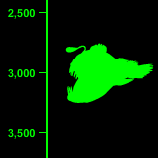
Deep Sea Anglerfish
(Melanocetus johnsoni)
The deep sea anglerfish is one of the most bizarre-looking fish in the sea. Known scientifically as Melanocetus johnsoni, it is also one of the best-known creatures of the deep. It is one of about 200 species of anglerfish found throughout the world's oceans. Of these, there are several dozen species that inhabit the deepest parts of the ocean. The angler gets its name from the elongated dorsal spine that supports a light-producing organ known as a photophore. Through a chemical process known as bioluminescence, this photophore can produce a blue-green light similar to that of a firefly on land. The anglerfish uses this appendage like a fishing lure, waving it back and forth to attract its prey. It lies still waiting for its hapless prey wanders close enough then gulps it down with lightning speed.
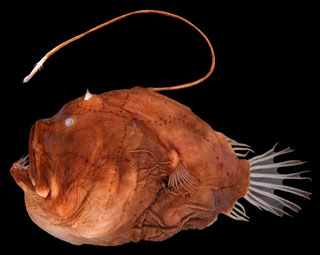
Deep sea anglerfish species Bufoceratias wedli
(© Masaki Miya et al. / CC BY 2.0)
The deep sea anglerfish has a round body that resembles a basketball, and indeed, it looks like it could easily swallow one. It has a very large mouth with sharp, fang-like teeth. Its grotesque appearance has earned it the nickname "common black devil". Despite its ferocious appearance, the angler is a small fish, reaching a maximum length of only about five inches (12 centimeters). The color of this anglerfish ranges from brown to dark gray or black. It has soft flesh and bones and small eyes. Its skin is specially adapted to reflect blue light. Since nearly all light emitted from bioluminescent creatures is blue, the anglerfish can be nearly invisible to other deep sea animals. Due to its wide, round body, it cannot swim very fast. Instead, it somewhat "wobbles" through the water.
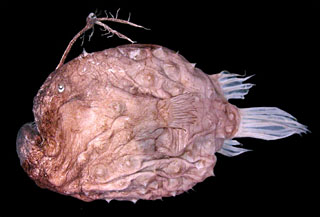
Deep sea anglerfish species Himantolophus appelii
(© Masaki Miya et al. / CC BY 2.0)
The anglerfish uses its illuminated lure as its hunts for prey. This specialized spine is highly maneuverable and can be moved in any direction. The anglerfish is known to remain completely motionless, waving its lure back and forth like a fishing pole. When the prey fish gets close enough, the angler snaps it up with its powerful jaws and swallows it whole. The sharp teeth of the angler are angled inwards, which helps to prevent the prey from escaping. The anglerfish can extend both its jaw and its stomach to an incredible size, allowing it to swallow prey twice the size of its entire body. Since food can be scarce in the deep sea, this special adaptation allows it to stock up on food during times of plenty.
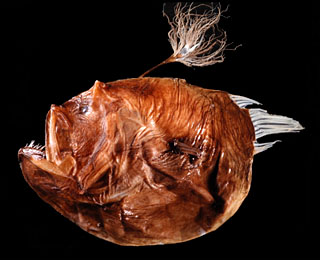
Deep sea anglerfish species Bufoceratias shaoi
(© Masaki Miya et al. / CC BY 2.0)
The deep sea anglerfish has an extremely unusual method of reproduction. The male angler is much smaller than the female and completely different in appearance. It is about the size of a small finger and black in color. When a male angler matures, its digestive system degenerates, making it impossible for it to feed on its own. It must now find a female or die of starvation. The male angler has small hook teeth, which it uses to attach itself to the female. Once he bites into her skin, he releases an enzyme that dissolves the skin of his mouth and that of her body. The two become fused together and their blood vessels join as one. The male will spend the rest of its life joined to the female like a parasite, getting all of his nourishment from her body. A female can carry up to six males on her body at a time. This bizarre method of reproduction helps to ensure that when the female is ready to spawn, she has a mate instantly available. The female will lay her eggs in a thin sheet of gelatinous material two or three feet (about one meter) wide and about 30 feet (9 meters) long. This thin sheet of eggs floats free in the sea until the eggs hatch into tiny larvae. Once hatched, the larvae swim to the surface and feed on plankton. As they mature, they return to the depths below.
The deep sea angler is found throughout the world's oceans at depths of over 3,000 feet (914 meters). At this depth, there is almost no light and the water is near freezing. Many species of anglerfish are fished commercially throughout the world. They are compared to lobster in taste and texture. In Japan, anglerfish is considered a delicacy and can fetch a premium price.
Deep Sea
Creature Database
'




